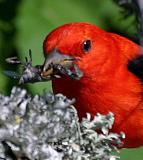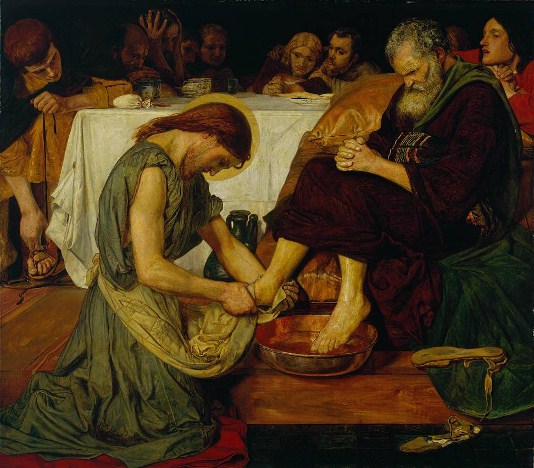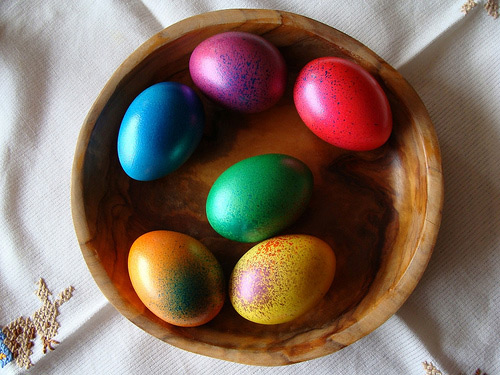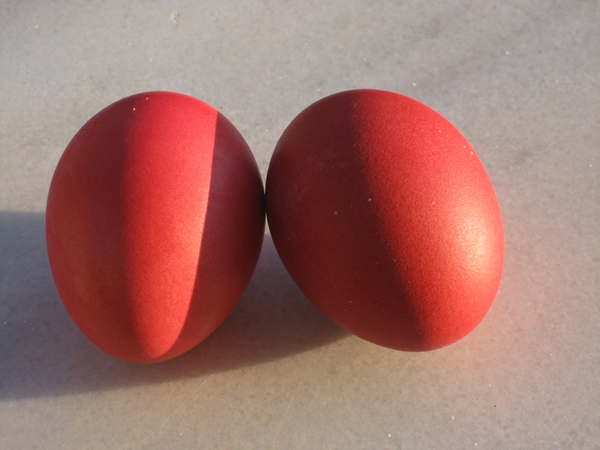The Esoteric Significance of Easter
Mar 30th, 2013 by admin
THE ESOTERIC SIGNIFICANCE OF EASTER AND THE INCEPTION OF THE ROSICRUCIAN PHILOSOPHY
by Max Heindel [illustrations added]
AGAIN the earth has reached the vernal equinox in its annual circle dance about the sun, and we have Easter. The spiritual ray sent out by the Cosmic Christ each autumn to replenish the smoldering vitality of the earth is about to ascend to the Father’s Throne. The spiritual activities of fecundation and germination which have been carried on during the winter and spring will be followed by material growth and a ripening process during the coming summer and fall under the influence of the indwelling Earth Spirit. The cycle ends at “Harvest Home.” Thus the great World Drama is acted and re-enacted from year to year, an eternal contest between life and death; each in turn becoming victor and being vanquished as the cycles roll on.
This great cyclic influx and efflux are not confined in their effects to the earth and its flora and fauna. They exercise an equally compelling influence upon mankind, though most individuals are unaware of what impels them to act in one direction or another.  Independent of one’s cognition, the same earthy vibration which gaudily adorns bird and beast in the spring moves the human desire to don gay colors and brighter raiment in that season. The same “call of the wild,” in summer drives mankind to relaxation amid rural scenes where nature spirits weave their magic art in field and forest, and man recuperates from the strain of artificial conditions in congested cities.
Independent of one’s cognition, the same earthy vibration which gaudily adorns bird and beast in the spring moves the human desire to don gay colors and brighter raiment in that season. The same “call of the wild,” in summer drives mankind to relaxation amid rural scenes where nature spirits weave their magic art in field and forest, and man recuperates from the strain of artificial conditions in congested cities.
On the other hand, the “fall” of the spiritual Ray from the sun in autumn causes a resumption of the mental and spiritual activities in winter. The same germinative force which leavens the seed in the earth and prepares it to reproduce a multitude of its kind stirs also the human mind and fosters altruistic activities that make the world better. This great wave of selfless Cosmic Love culminates at Christmas, vibrating peace and good will, filling our breasts with a holiday feeling and engendering a desire to make others happy; without this universal wave of generosity, Christmas gifts would be impossible, and we would all suffer loss.
As the Christ walked day by day hither and yon, over the hills and the valleys of Judea and Galilee, teaching the multitudes, all were benefited. But He communed most with His disciples, and they, of course, grew rapidly each day. The bond of love became closer as time went on until one day ruthless hands took away the beloved Teacher and put Him to a shameful death. But though He had died in the flesh, he continued for some time to commune with them in spirit.
At last, however, He ascended to higher spheres and direct touch with Him was lost; sadly these men looked into each other’s faces as they asked, “Is this the end?” They had hoped so much, had entertained such high aspirations, and though the verdant glory was as fresh upon the sun-kissed landscape as before He went, the earth seemed cold and dreary, for black desolation gnawed at their hearts.
Thus it is also with us who aim to walk after the spirit and to strive with the flesh, though the analogy may not be apparent. When the “fall” of the Christ ray commences in autumn and ushers in the season of spiritual supremacy, we sense it at once and begin to lave our souls in the blessed tide with avidity. We experience a feeling akin to that of the apostles when they walked with Christ, and as the season wears on it becomes easier and easier to commune with Him, face to face as it were.
But in the annual course of events Easter and the ascension of the “risen” Christ ray to the Father leave us in the identical position of the apostles when their beloved Teacher went away. We are desolate and sad; we look upon the world as a dreary waste and cannot comprehend the reason for our loss, which is as natural as the changes of ebb and flood and day and night—phases of the present age of alternating cycles.
There is a danger in this attitude of mind. If it is allowed to grow upon us, we are apt to cease our work in the world and become dreamers, lose our balance, and excite just criticism from our fellow men. Such a course of conduct is entirely wrong, for as the earth exerts itself in material endeavor to bring forth abundantly in summer after receiving the spiritual impetus in winter, so ought we also to exert ourselves to greater purpose in the world’s work when it has been our privilege to commune with the spirit. If we do thus we shall be more apt to excite emulation than reproach.
We are inclined to think of a miser as one who hoards gold, and such people are generally objects of contempt. But there are people who strive as assiduously to acquire knowledge as the miser struggles to accumulate gold; they will stoop to any subterfuge to obtain their desire, and will as jealously guard their knowledge as the miser guards his hoard. They do not understand that by such a method they are effectually closing the door to greater wisdom.
The Old Norse theology contained a parable which symbolically elucidates the matter. It held that all those who died fighting on the battle field (the strong souls who fought the good fight until the end) were carried to Valhalla to be with the gods; while those who died in bed or from disease (the souls who drifted weakly through life) went to the dismal Niflheim. The doughty warriors in Valhalla feasted daily upon the flesh of the boar called Scrimner, which was so constituted that whenever a portion was cut from the flesh it at once grew again, so that it was never consumed no matter how much was carved. Thus it aptly symbolized “knowledge,” for no matter how much of this we give to others, we always retain the original.
There is thus a certain obligation to pass on what we have of knowledge, and “to whom much is given of him much will be required.” Perhaps it may not be out of place to recount an experience which will illustrate the point, for it was the final “test” applied to myself before I was entrusted with the teaching embodied in The Rosicrucian Cosmo-Conception, although I was, of course, at the time unaware that I was being weighed. It occurred at a time when I had gone to Europe in search of a teacher who, I believed, was able to aid me to advance on the path of attainment. But when I had probed his teaching to the bottom and forced him to admit certain inconsistencies in it which he could not explain, I was in a veritable “slough of despond,”* ready to return to America.
As I sat in my chair ruminating over my disappointment, the feeling that some one else was present came over me, and I looked up and beheld the One who has since become my Teacher. With shame I remember how gruffly I asked who had sent him and what he wanted, for I was thoroughly disgruntled, and I hesitated considerably before accepting his help on the points that had caused me to come to Europe.
During the next few days my new acquaintance appeared in my room a number of times, answering my questions and helping me to solve problems that had previously baffled me, but as my spiritual sight was then poorly developed and not always under control, I felt rather skeptical in the matter. Might it not be hallucination? I discussed the question with a friend. The answers to my queries as given by the apparition were clear, concise, and logical to a high degree. They were strictly to the point and altogether beyond anything I was capable of conceiving, so we concluded that the experience must be real.
A few days later my new friend told me that the Order to which he belonged had a complete solution to the riddle of the universe, much more far-reaching than any publicly known teaching, and that they would impart that teaching to me provided I agreed to keep it as an inviolable secret.
Then I turned on him in anger: “Ah! do I see the cloven hoof at last! No, if you have what you say and if it is good for the world to know. The Bible expressly forbids us to hide the Light, and I care not to feast at the source of knowledge while thousands of souls hunger for a solution to their problems as I do now.” My visitor then left me and stayed away, and I concluded that he was an emissary from the Black Brothers.
About a month later I decided that I could obtain no greater illumination in Europe and therefore made reservation on a steamer for New York. As travel was heavy, I had to wait a month for a berth.
When I returned to my rooms after having purchased my ticket, there stood my slighted Teacher and he again offered me instruction on condition that I keep it secret. This time my refusal was perhaps more emphatic and indignant than before, but he did not leave. Instead he said, “I am glad to hear you refuse, my brother, and I hope you will always be as zealous in disseminating our teachings without fear or favor as you have been in this refusal. That is the real condition of receiving the teachings.”
How directions were then given me to take a certain train at a certain depot and go to a place I had not heard of before, how I there met the Brother in the flesh, was taken to the Temple, and received the main instructions embodied in our literature, are matters of small interest.
The point is that had I agreed to keep the instructions secret, I should naturally have been unfit to be a messenger of the Brothers, and they would have had to seek another. Likewise with any of us: if we hoard the spiritual blessings we have received, evil is at our door, so let us imitate the earth at this Easter time. Let us bring forth in the physical world of action the fruits of the spirit sown in our souls during the past wintry season. So shall we be more abundantly blessed from year to year.
AND again it is Easter. The dark, dreary days of winter are past. Mother nature is taking the cold, snowy coverlids off the earth, and the millions and millions of seeds sheltered in the soft soil are bursting its crust and clothing the earth in summer robes, a riot of gay and glorious colors, preparing the bridal bower for the mating of beasts and birds. Even in this war-torn year the song of life sounds loudly above the dirge of death. “O death, where is thy sting? O grave, where is thy victory?” Christ has arisen—the first fruits. He is the resurrection and the life; whosoever believeth in him shall not perish but have everlasting life.
Thus at the present season the mind of the civilized world is turned toward the feast we call Easter, commemorating the death and resurrection of the individual whose life story is written in the Gospels, the noble individual known to the world by the name of Jesus. But a Christian mystic takes a deeper and more far-reaching view of this annually recurring cosmic event.
For him there is an annual impregnation of the earth with the cosmic Christ life; an inbreathing which takes place during the fall months and culminates at the winter solstice when we celebrate Christmas, and an out-breathing which finds its completion at the time of Easter. The inbreathing or impregnation is manifested to us in the seeming inactivity of winter, but the out-breathing of the Christ life manifests as the resurrection force which gives new life to all that lives and moves upon the earth, life abundant, not only to sustain but to propagate and perpetuate.
Thus the cosmic drama of life and death is played annually among all evolving creatures and things from the highest to the lowest, for even the great and sublime cosmic Christ in His compassion becomes subject to death by entering the cramping conditions of our earth for a part of the year. It may therefore be appropriate to call to mind a few ideas concerning death and rebirth which we are sometimes prone to forget.
Resurrection and the Egg as a Creative Symbol
From Teachings of an Initiate – The Lesson of Easter
Among the cosmic symbols which have been handed down to us from antiquity none is more common than the symbol of the egg. It is found in every religion. We find it in the Elder Eddas of the Scandinavians, hoary with age, which tell of the mundane egg cooled by the icy blast of Niebelheim but heated by the fiery breath of Muspelheim until the various worlds and man had come into being.
If we turn to the sunny south we find in the Vedas of India the same story in the Kalahansa, the Swan in time and space, which laid the egg that finally became the world. Among the Egyptians we find the winged globe and the oviparous serpent, symbolizing the wisdom manifest in this world of ours.
Then the Greeks took this symbol and venerated it in their Mysteries. It was preserved by the Druids; it was known to the builders of the great serpent mound in Ohio; and it has kept its place in sacred symbolism even to this day, though most are blind to the Mysterium Magnum which it hides and reveals—the mystery of life.
When we break open the shell of an egg, we find inside only some varicolored viscous fluids of various consistencies. But placed in the requisite temperature a series of changes soon take place, and within a short time a living creature breaks open the shell and emerges, ready to take its place among its kin. It is possible for the wizards of the laboratory to duplicate the substances in the egg; they may be enclosed in a shell, and a perfect replica so far as most tests go may be made of the natural egg. But in one point it differs from the natural egg, namely, that no living thing can be hatched from the artificial product. Therefore it is evident that a certain intangible something must be present in one and absent in the other.
This mystery of the ages which produces the living creature is what we call life. Seeing that it cannot be cognized among the elements of the egg by even the most powerful microscope (though it must be there to bring about the changes), it must be able to exist independently of matter. Thus we are taught by the sacred symbol of the egg that though life is able to mold matter, it does not depend upon it for its existence. It is self-existent, and having no beginning it can have no end. This is symbolized by the ovoid shape of the egg.
We are appalled at the carnage on the European battle fields, and rightly so because of the manner in which the victims are being taken out of physical life. But when we consider that the average human life is only fifty years or less, so that death reaps a harvest of fifteen hundred million in half a century, or thirty million per annum, or two and one-half million every month, we see that the total has not been so greatly increased after all.
And when we have the true knowledge conveyed by the egg symbol that life is without beginning and without end, it enables us to take heart and realize that those who are now being taken out of physical existence are only passing through a cyclic journey similar to that of the cosmic Christ life which enters the earth in the fall and leaves it at Easter. Those who are killed are only going into the invisible realms, where they will later take a new dip into physical matter, entering as all living things do the egg of the mother. After a period of gestation they will re-emerge into physical life to learn new lessons in the great school. Thus we see how the great law of analogy works in all phases and under all circumstances of life. What happens in the great world to a cosmic Christ will manifest also in the lives of those who are Christs in the making; and this will enable us to look more cheerfully upon the present struggle than would otherwise be the case.
Furthermore, we must realize that death is a cosmic necessity under the present circumstances for if we were imprisoned in a body of the kind we now use and placed in an environment such as we find today, there to live forever, the infirmities of the body and the unsatisfactory nature of the environment would very soon make us so tired of life that we would cry for release. It would block all progress and make it impossible for us to evolve to greater heights such as we may evolve to by re-embodiment in new vehicles and placement in new environments which give us new possibilities of growth.
Thus we may thank God that so long as birth into a concrete body is necessary for our further development, release by death has been provided to free us from the outgrown instrument. Resurrection and a new birth under the smiling skies of a new environment furnish us with another chance to begin life with a clean slate and learn the lessons which we failed to master before. By this method we shall at some time become perfect as is the risen Christ. He commanded it, and he will aid us to achieve it.
* [The Slough of Despond: a deep bog into which Christian falls on the way from the City of Destruction and from which Help saves him in the allegory Pilgrim’s Progress (1678) by John Bunyan]








